+ Open data
Open data
- Basic information
Basic information
| Entry |  | |||||||||
|---|---|---|---|---|---|---|---|---|---|---|
| Title | FCP trimer in diatom Thalassiosira pseudonana | |||||||||
 Map data Map data | ||||||||||
 Sample Sample |
| |||||||||
 Keywords Keywords | FCP trimer / PHOTOSYNTHESIS | |||||||||
| Function / homology |  Function and homology information Function and homology informationlight-harvesting complex / photosynthesis, light harvesting in photosystem I / photosystem II / chlorophyll binding / chloroplast thylakoid membrane / response to light stimulus Similarity search - Function | |||||||||
| Biological species |  Thalassiosira pseudonana CCMP1335 (Diatom) Thalassiosira pseudonana CCMP1335 (Diatom) | |||||||||
| Method | single particle reconstruction / cryo EM / Resolution: 2.73 Å | |||||||||
 Authors Authors | Feng Y / Li Z / Zhou CC / Liu C / Shen JR / Wang W | |||||||||
| Funding support |  China, 1 items China, 1 items
| |||||||||
 Citation Citation |  Journal: Plant Commun / Year: 2024 Journal: Plant Commun / Year: 2024Title: Structural and spectroscopic insights into fucoxanthin chlorophyll a/c-binding proteins of diatoms in diverse oligomeric states. Authors: Cuicui Zhou / Yue Feng / Zhenhua Li / Lili Shen / Xiaoyi Li / Yumei Wang / Guangye Han / Tingyun Kuang / Cheng Liu / Jian-Ren Shen / Wenda Wang /   Abstract: Diatoms, a group of prevalent marine algae, contribute significantly to global primary productivity. Their substantial biomass is linked to enhanced absorption of blue-green light underwater, ...Diatoms, a group of prevalent marine algae, contribute significantly to global primary productivity. Their substantial biomass is linked to enhanced absorption of blue-green light underwater, facilitated by fucoxanthin chlorophyll (Chl) a/c-binding proteins (FCPs), which exhibit oligomeric diversity across diatom species. Using mild clear native PAGE analysis of solubilized thylakoid membranes, we displayed monomeric, dimeric, trimeric, tetrameric, and pentameric FCPs in diatoms. Mass spectrometry analysis revealed that each oligomeric FCP has a specific protein composition, and together they constitute a large Lhcf family of FCP antennas. In addition, we resolved the structures of the Thalassiosira pseudonana FCP (Tp-FCP) homotrimer and the Chaetoceros gracilis FCP (Cg-FCP) pentamer by cryoelectron microscopy at 2.73-Å and 2.65-Å resolution, respectively. The distinct pigment compositions and organizations of various oligomeric FCPs affect their blue-green light-harvesting, excitation energy transfer pathways. Compared with dimeric and trimeric FCPs, the Cg-FCP tetramer and Cg-FCP pentamer exhibit stronger absorption by Chl c, redshifted and broader Chl a fluorescence emission, and more robust circular dichroism signals originating from Chl a-carotenoid dimers. These spectroscopic characteristics indicate that Chl a molecules in the Cg-FCP tetramer and Cg-FCP pentamer are more heterogeneous than in both dimers and the Tp-FCP trimer. The structural and spectroscopic insights provided by this study contribute to a better understanding of the mechanisms that empower diatoms to adapt to fluctuating light environments. | |||||||||
| History |
|
- Structure visualization
Structure visualization
| Supplemental images |
|---|
- Downloads & links
Downloads & links
-EMDB archive
| Map data |  emd_36466.map.gz emd_36466.map.gz | 32.1 MB |  EMDB map data format EMDB map data format | |
|---|---|---|---|---|
| Header (meta data) |  emd-36466-v30.xml emd-36466-v30.xml emd-36466.xml emd-36466.xml | 16.8 KB 16.8 KB | Display Display |  EMDB header EMDB header |
| FSC (resolution estimation) |  emd_36466_fsc.xml emd_36466_fsc.xml | 8.4 KB | Display |  FSC data file FSC data file |
| Images |  emd_36466.png emd_36466.png | 109 KB | ||
| Filedesc metadata |  emd-36466.cif.gz emd-36466.cif.gz | 5.3 KB | ||
| Others |  emd_36466_additional_1.map.gz emd_36466_additional_1.map.gz emd_36466_half_map_1.map.gz emd_36466_half_map_1.map.gz emd_36466_half_map_2.map.gz emd_36466_half_map_2.map.gz | 59.8 MB 59.4 MB 59.4 MB | ||
| Archive directory |  http://ftp.pdbj.org/pub/emdb/structures/EMD-36466 http://ftp.pdbj.org/pub/emdb/structures/EMD-36466 ftp://ftp.pdbj.org/pub/emdb/structures/EMD-36466 ftp://ftp.pdbj.org/pub/emdb/structures/EMD-36466 | HTTPS FTP |
-Validation report
| Summary document |  emd_36466_validation.pdf.gz emd_36466_validation.pdf.gz | 725.9 KB | Display |  EMDB validaton report EMDB validaton report |
|---|---|---|---|---|
| Full document |  emd_36466_full_validation.pdf.gz emd_36466_full_validation.pdf.gz | 725.5 KB | Display | |
| Data in XML |  emd_36466_validation.xml.gz emd_36466_validation.xml.gz | 16.2 KB | Display | |
| Data in CIF |  emd_36466_validation.cif.gz emd_36466_validation.cif.gz | 20.8 KB | Display | |
| Arichive directory |  https://ftp.pdbj.org/pub/emdb/validation_reports/EMD-36466 https://ftp.pdbj.org/pub/emdb/validation_reports/EMD-36466 ftp://ftp.pdbj.org/pub/emdb/validation_reports/EMD-36466 ftp://ftp.pdbj.org/pub/emdb/validation_reports/EMD-36466 | HTTPS FTP |
-Related structure data
| Related structure data |  8jp3MC  8wckC  8wclC M: atomic model generated by this map C: citing same article ( |
|---|---|
| Similar structure data | Similarity search - Function & homology  F&H Search F&H Search |
- Links
Links
| EMDB pages |  EMDB (EBI/PDBe) / EMDB (EBI/PDBe) /  EMDataResource EMDataResource |
|---|---|
| Related items in Molecule of the Month |
- Map
Map
| File |  Download / File: emd_36466.map.gz / Format: CCP4 / Size: 64 MB / Type: IMAGE STORED AS FLOATING POINT NUMBER (4 BYTES) Download / File: emd_36466.map.gz / Format: CCP4 / Size: 64 MB / Type: IMAGE STORED AS FLOATING POINT NUMBER (4 BYTES) | ||||||||||||||||||||||||||||||||||||
|---|---|---|---|---|---|---|---|---|---|---|---|---|---|---|---|---|---|---|---|---|---|---|---|---|---|---|---|---|---|---|---|---|---|---|---|---|---|
| Projections & slices | Image control
Images are generated by Spider. | ||||||||||||||||||||||||||||||||||||
| Voxel size | X=Y=Z: 1.04 Å | ||||||||||||||||||||||||||||||||||||
| Density |
| ||||||||||||||||||||||||||||||||||||
| Symmetry | Space group: 1 | ||||||||||||||||||||||||||||||||||||
| Details | EMDB XML:
|
-Supplemental data
-Additional map: #1
| File | emd_36466_additional_1.map | ||||||||||||
|---|---|---|---|---|---|---|---|---|---|---|---|---|---|
| Projections & Slices |
| ||||||||||||
| Density Histograms |
-Half map: #2
| File | emd_36466_half_map_1.map | ||||||||||||
|---|---|---|---|---|---|---|---|---|---|---|---|---|---|
| Projections & Slices |
| ||||||||||||
| Density Histograms |
-Half map: #1
| File | emd_36466_half_map_2.map | ||||||||||||
|---|---|---|---|---|---|---|---|---|---|---|---|---|---|
| Projections & Slices |
| ||||||||||||
| Density Histograms |
- Sample components
Sample components
-Entire : FCP trimer
| Entire | Name: FCP trimer |
|---|---|
| Components |
|
-Supramolecule #1: FCP trimer
| Supramolecule | Name: FCP trimer / type: complex / ID: 1 / Parent: 0 / Macromolecule list: #1 |
|---|---|
| Source (natural) | Organism:  Thalassiosira pseudonana CCMP1335 (Diatom) Thalassiosira pseudonana CCMP1335 (Diatom) |
-Macromolecule #1: Fucoxanthin chlorophyll a/c protein 8
| Macromolecule | Name: Fucoxanthin chlorophyll a/c protein 8 / type: protein_or_peptide / ID: 1 / Number of copies: 3 / Enantiomer: LEVO |
|---|---|
| Source (natural) | Organism:  Thalassiosira pseudonana CCMP1335 (Diatom) Thalassiosira pseudonana CCMP1335 (Diatom) |
| Molecular weight | Theoretical: 19.652232 KDa |
| Sequence | String: AFEDELGAQA PLGFFDPFGM LSGDCTQERF DRLRYVEIKH GRIAQLAFLG QVVTRAGIHL PGSINYAGDS FDSFPNGVAA LFGPNSIPT AGLVQIISFI GILECAFMRD VPGTGNEHVG DFRNGYIDFG WDEFDEETKL SKRAIELNNG RAAMMGILGL M VHEEIIPL GYDADLPIIG HL UniProtKB: Fucoxanthin chlorophyll a/c protein 8 |
-Macromolecule #2: (3S,3'S,5R,5'R,6S,6'R,8'R)-3,5'-dihydroxy-8-oxo-6',7'-didehydro-5...
| Macromolecule | Name: (3S,3'S,5R,5'R,6S,6'R,8'R)-3,5'-dihydroxy-8-oxo-6',7'-didehydro-5,5',6,6',7,8-hexahydro-5,6-epoxy-beta,beta-caroten-3'- yl acetate type: ligand / ID: 2 / Number of copies: 21 / Formula: A86 |
|---|---|
| Molecular weight | Theoretical: 658.906 Da |
-Macromolecule #3: CHLOROPHYLL A
| Macromolecule | Name: CHLOROPHYLL A / type: ligand / ID: 3 / Number of copies: 24 / Formula: CLA |
|---|---|
| Molecular weight | Theoretical: 893.489 Da |
| Chemical component information | 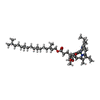 ChemComp-CLA: |
-Macromolecule #4: Chlorophyll c2
| Macromolecule | Name: Chlorophyll c2 / type: ligand / ID: 4 / Number of copies: 6 / Formula: KC2 |
|---|---|
| Molecular weight | Theoretical: 608.926 Da |
| Chemical component information |  ChemComp-KC2: |
-Macromolecule #5: Chlorophyll c1
| Macromolecule | Name: Chlorophyll c1 / type: ligand / ID: 5 / Number of copies: 3 / Formula: KC1 |
|---|---|
| Molecular weight | Theoretical: 610.941 Da |
| Chemical component information | 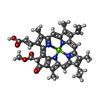 ChemComp-KC1: |
-Macromolecule #6: 1,2-DISTEAROYL-MONOGALACTOSYL-DIGLYCERIDE
| Macromolecule | Name: 1,2-DISTEAROYL-MONOGALACTOSYL-DIGLYCERIDE / type: ligand / ID: 6 / Number of copies: 3 / Formula: LMG |
|---|---|
| Molecular weight | Theoretical: 787.158 Da |
| Chemical component information | 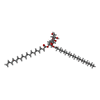 ChemComp-LMG: |
-Experimental details
-Structure determination
| Method | cryo EM |
|---|---|
 Processing Processing | single particle reconstruction |
| Aggregation state | particle |
- Sample preparation
Sample preparation
| Buffer | pH: 6.5 |
|---|---|
| Vitrification | Cryogen name: ETHANE |
- Electron microscopy
Electron microscopy
| Microscope | FEI TITAN KRIOS |
|---|---|
| Image recording | Film or detector model: GATAN K3 (6k x 4k) / Average electron dose: 60.0 e/Å2 |
| Electron beam | Acceleration voltage: 300 kV / Electron source:  FIELD EMISSION GUN FIELD EMISSION GUN |
| Electron optics | Illumination mode: FLOOD BEAM / Imaging mode: BRIGHT FIELD / Nominal defocus max: 2.0 µm / Nominal defocus min: 1.0 µm |
| Experimental equipment |  Model: Titan Krios / Image courtesy: FEI Company |
 Movie
Movie Controller
Controller



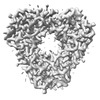


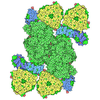
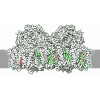
 Z (Sec.)
Z (Sec.) Y (Row.)
Y (Row.) X (Col.)
X (Col.)













































